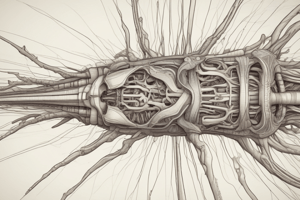Podcast
Questions and Answers
¿Cuál es el segmento que se encuentra en la región lumbar?
¿Cuál es el segmento que se encuentra en la región lumbar?
- Cervical
- Lumbar (correct)
- Torácico
- Sacral
¿Qué segmento porta la sensación del cuero cabelludo y la nuca?
¿Qué segmento porta la sensación del cuero cabelludo y la nuca?
- Torácico
- Lumbar
- Sacral
- Cervical (correct)
¿Dónde se encuentra el conus medullaris?
¿Dónde se encuentra el conus medullaris?
- En la región lumbar
- En la región cervical
- En la región torácica
- Entre los niveles vertebrales L1 y L2 (correct)
¿Cuál es el segmento que se considera vestigial?
¿Cuál es el segmento que se considera vestigial?
¿Qué segmento controla los músculos del diafragma?
¿Qué segmento controla los músculos del diafragma?
¿Cuántos segmentos componen la médula espinal?
¿Cuántos segmentos componen la médula espinal?
¿Cuál es el rango de segmentos que se encuentran en la región cervical?
¿Cuál es el rango de segmentos que se encuentran en la región cervical?
¿Qué segmentos controlan los músculos del tórax y abdomen?
¿Qué segmentos controlan los músculos del tórax y abdomen?
¿Cuál es la función de los segmentos lumbares?
¿Cuál es la función de los segmentos lumbares?
¿Qué problema de salud puede resultar de una lesión en los segmentos sacros?
¿Qué problema de salud puede resultar de una lesión en los segmentos sacros?
Flashcards are hidden until you start studying
Study Notes
Spinal Cord Anatomy and Location: An Overview of Spinal Cord Segments
The spinal cord is a long, tube-shaped extension of the central nervous system that runs from the brain through the vertebral column to the lower back. It is responsible for relaying sensory information to the brain and facilitating motor control of the body. The spinal cord is divided into four regions: cervical, thoracic, lumbar, and sacral. Each region contains specific segments, and damage to these segments can result in various health conditions.
Spinal Cord Segments
The spinal cord is composed of 31 segments, which are numbered and named according to the vertebrae they are associated with. The segments are as follows:
- Cervical (C) segments: C1 to C7, located in the neck region. These segments contribute to the formation of the phrenic nerve, which innervates the diaphragm, and provide motor control for the upper extremities and related muscles.
- Thoracic (T) segments: T1 to T12, located in the chest region. These segments provide motor control to the thoracoabdominal musculature.
- Lumbar (L) segments: L1 to L5, located in the lower back region. These segments control the lower extremities and related muscles.
- Sacral (S) segments: S1 to S5, located in the lower back region. These segments control the thighs, lower legs, genital, and anal areas, and injury can lead to lower back pain, urinary incontinence or retention, loss of feeling in the foot, and sexual dysfunction.
- Coccygeal (Co) segment: This is a mainly vestigial segment located in the lower back, close to the sacral region.
In addition to these segments, the spinal cord has a conus medullaris, which is the cone-shaped termination of the caudal cord. The conus medullaris is located at the L1 to L2 vertebral levels and is the level where the spinal cord ends.
Functions of Spinal Cord Segments
Each segment of the spinal cord has specific functions related to sensory, motor, and autonomic processes. For example:
- Cervical (C) segments: C1-2 carry sensation from the back of the head and scalp, along with motor innervation to several muscles in the neck. C3-5 contribute to the formation of the phrenic nerve, which innervates the diaphragm, and provide motor control for the upper extremities and related muscles.
- Thoracic (T) segments: T1-12 provide motor control to the thoracoabdominal musculature.
- Lumbar (L) segments: L1-5 control the lower extremities and related muscles.
- Sacral (S) segments: S1-5 control the thighs, lower legs, genital, and anal areas.
Damage to these segments can result in various health conditions, such as cervical radiculopathy, thoracic paraplegia, lumbar radiculopathy, and sacral nerve injury.
In conclusion, understanding the spinal cord anatomy and location, particularly the segments, is essential for recognizing the importance of the spinal cord and its role in relaying sensory information to the brain and facilitating motor control. By learning about the different segments and their functions, we can appreciate the intricacy of the nervous system and the potential consequences of damage to specific regions.
Studying That Suits You
Use AI to generate personalized quizzes and flashcards to suit your learning preferences.




